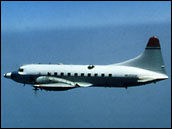While satellite instruments can show scientists that clouds are getting
brighter from ships’ smokestacks, the images cannot tell them anything
about the details of the processes behind the phenomenon. For that, the
scientists have to take measurements inside the ship tracks themselves.
|
|
|
King and Coakley collaborated with researchers from the University of
Washington to analyze data on solar radiation and cloud properties inside clouds
that were modified by ships. "We flew an airplane through the clouds and
monitored the pollution from the ships at the same time the satellite went over
them," said King. The research plane was equipped with an array of gadgets that
measure the light bouncing around inside the clouds, the water content there,
the size of the water droplets, and many other variables. To take these
measurements, the aircraft traveled 100 kilometers through the middle of the
low-lying clouds (Radke et al. 1989).
As the aircraft sped out to sea, it encountered two 10-kilometer strips
within the clouds that had very different properties. Across these strips, the
number of water droplets per cubic centimeter more than doubled, the radius of
the drops decreased by roughly six percent and the amount of water per cubic
meter increased twofold (King et al 1993). "The first two results were what
we expected to happen with ship tracks, but the third one was not
expected," said King.
No one had predicted that this excessive cloud seeding from the ship would
cause the clouds to retain more water. King explained that rain forms when
cloud drops coagulate and reach a size where gravity can pull them to the
ground. Yet, in the ship tracks the scientists observed, the cloud seeding made
the drops so small that they could no longer easily merge together to reach the
size needed to escape. Since no drizzle came out of the seeded clouds, the
liquid water just kept building in the cloud. "This effect worked in
exactly the same direction as the other two effects — all three made the
cloud brighter and more reflective to incoming sunlight, especially in the
near-infrared part of the spectrum," said King. The satellite data they
received showed that the clouds that had been enhanced by the ship tracks were
13 percent brighter (King et al. 1993).
 A Cloudy Future A Cloudy Future
 Searching for Ship Tracks Searching for Ship Tracks
|
|

The University of Washington Convair C-131A measured aerosol,
ship track, and cloud properties directly. The measurements confirm that sulfate aerosols form the ship tracks with larger numbers of smaller water droplets than contained in unpolluted clouds. (Photograph courtesy Dr. John S. Foot, U.K. Meteorological Office)
|

